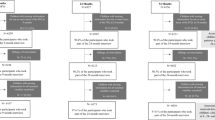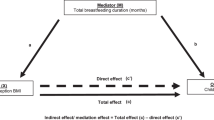Abstract
Background/Objectives:
To examine whether a relationship exists between exclusive breastfeeding duration and later vegetable consumption in 4-year-old children, independently of factors traditionally associated with children's vegetable intake.
Subjects/Methods:
A longitudinal study using information collected on children's food consumption patterns and behaviors from a representative sample of children born in 1998 in the province of Québec, Canada. Face-to-face interviews and self-administered questionnaires were addressed to children's mothers and fathers. From the first group of children (n=2100) included in the cohort, a subsample of 4-year-old children participated in a nutrition substudy (n=1549).
Results:
Children whose mothers held a university degree had odds of 8.7 (95% CI: 4.23–17.93) for consuming two or more servings of vegetables a day at 4 years of age (vs less than one serving per day) in comparison to children of mothers with no high school diploma. Likewise, children who were exclusively breastfed for 3 or more months had odds of 2.6 (95% CI: 1.34–5.02, with 3 to <4 months of exclusive breastfeeding) and 1.9 (95% CI: 1.01–3.61, with 4 or more months of exclusive breastfeeding) for consuming two or more servings of vegetables per day (vs less than one serving per day) in comparison to children who were formula-fed and/or partially breastfed (no exclusive breastfeeding).
Conclusions:
The findings suggest that three or more months of exclusive breastfeeding is a predictive factor for higher vegetable consumption in preschool children.
This is a preview of subscription content, access via your institution
Access options
Subscribe to this journal
Receive 12 print issues and online access
$259.00 per year
only $21.58 per issue
Buy this article
- Purchase on Springer Link
- Instant access to full article PDF
Prices may be subject to local taxes which are calculated during checkout
Similar content being viewed by others
References
Antova T, Pattenden S, Nikiforov B, Leonardi GS, Boeva B, Fletcher T et al. (2003). Nutrition and respiratory health in children in six Central and Eastern European countries. Thorax 58, 231–236.
Birch LL (1999). Development of food preferences. Annu Rev Nutr 19, 41–62.
Black AE, Goldberg GR, Jebb SA, Livingstone MB, Cole TJ, Prentice AM (1991). Critical-evaluation of energy-intake data using fundamental principles of energy physiology. 2. Evaluating the results of published surveys. Eur J Clin Nutr 45, 583–599.
Bolling K, Grant K, Hamlyn B, Thornton A (2007). Infant Feeding Survey 2005. Information Centre, Government Statistical Service: United Kingdom.
Cooke LJ, Wardle J, Gibson EL, Sapochnik M, Sheiham A, Lawson M (2004). Demographic, familial and trait predictors of fruit and vegetable consumption by pre-school children. Public Health Nutr 7, 295–302.
Cox GG, Cohen SB (1995). Methodological Issues for Health Care Surveys. Marcel Dekker: New York.
Drewnowski A (1997). Taste preferences and food intake. Annu Rev Nutr 17, 237–253.
Dubois L, Bédard B, Girard M, Beauchesne E (2000). Diet. Longitudinal Study of Child Development in Québec (ELDEQ 1998–2002). Institut de la Statistique du Québec: Québec.
Dubois L, Girard M (2003). Social determinants of initiation, duration and exclusivity of breastfeeding at the population level—the results of the Longitudinal Study of Child Development in Quebec (ELDEQ 1998–2002). Can J Public Health 94, 300–305.
Fisher JO, Birch LL, Smiciklas-Wright H, Picciano MF (2000). Breast-feeding through the first year predicts maternal control in feeding and subsequent toddler energy intakes. J Am Diet Assoc 100, 641–646.
Forestell CA, Mennella JA (2007). Early determinants of fruit and vegetable acceptance. Pediatrics 120, 1247–1254.
Galloway AT, Lee Y, Birch LL (2003). Predictors and consequences of food neophobia and pickiness in young girls. J Am Diet Assoc 103, 692–698.
Garriguet D (2007). More fruit, less fat: Canadians’ eating habits. Transition Magazine 37, 4.
Gojard S (2000). L’allaitement, pratiques et discours. Une approche sociologique. Rev euro dév enf [12, 4], 35–55.
Goran MI (1998). Measurement issues related to studies of childhood obesity: assessment of body composition, body fat distribution, physical activity, and food intake. Pediatrics 101, 505–518.
Haiek LN, Neill G, Plante N, Beauvais B (2006). L’allaitement Maternel au Québec: Coup d’oeil sur les Pratiques Provinciales et Régionales. Institut de la statistique du Québec: Québec.
Health Canada (2001). Canadian Nutrient File. Health Canada: Ottawa.
Health Canada (2004). Exclusive Breastfeeding Duration. Health Canada: Ottawa.
Health Canada (2005). Canada's Food Guide to Healthy Eating. Health Canada: Ottawa.
Health Canada (2007). Eating Well with Canada's Food Guide. Health Canada: Ottawa.
Johnson RK, Driscoll P, Goran MI (1996. Comparison of multiple-pass 24-hour recall estimates of energy intake with total energy expenditure determined by the doubly labeled water method in young children. J Am Diet Assoc 96, 1140–1144.
Joshipura KJ, Hu FB, Manson JE, Stampfer MJ, Rimm EB, Speizer FE et al. (2001). The effect of fruit and vegetable intake on risk for coronary heart disease. Ann Intern Med 134, 1106–1114.
Liu K, Stamler J, Dyer A, Mckeever J, Mckeever P (1978). Statistical-methods to assess and minimize role of intra-individual variability in obscuring relationship between dietary lipids and serum-cholesterol. J Chronic Dis 31, 399–418.
Livingstone MBE, Robson PJ (2000). Measurement of dietary intake in children. Proc Nutr Soc 59, 279–293.
Lutter CK (2000). Breastfeeding promotion—is its effectiveness supported by scientific evidence and global changes in breastfeeding behaviors? Short and long term effects of breast feeding on child health. Adv Exp Med Biol 478, 355–368.
Maynard M, Gunnell D, Emmett P, Frankel S, Smith GD (2003). Fruit, vegetables, and antioxidants in childhood and risk of adult cancer: the Boyd Orr cohort. J Epidemiol Community Health 57, 218–225.
McPherson RS, Hoelschler DM, Alexander M, Scanlon KS, Serdula MK (2000). Dietary assessment methods among school-aged children: validity and reliability. Prev Med 31, S11–S33.
Mennella JA, Jagnow CP, Beauchamp GK (2001). Prenatal and postnatal flavor learning by human infants. Pediatrics 107, art-e88.
National Research Council (1986). Nutrient Adequacy: Assessment Using Food Consumption Surveys. National Academy Press: Washington, DC.
Nicklaus S, Boggio V, Chabanet C, Issanchou S (2004). A prospective study of food preferences in childhood. Food Qual Pref 15, 805–818.
Northstone K, Emmett P (2005). Multivariate analysis of diet in children at four and seven years of age and associations with socio-demographic characteristics. Eur J Clin Nutr 59, 751–760.
Rasmussen M, Krolner R, Klepp KI, Lytle L, Brug J, Bere E et al. (2006). Determinants of fruit and vegetable consumption among children and adolescents: a review of the literature. Part I: quantitative studies. Int J Behav Nutr Phys Act 3, 22.
Regnier F, Masullo A (2008). Une Affaire de Goût? Réception et mise en Pratique des Recommandations Nutritionnelles. Institut National de la recherche agronomique (INRA): Paris, France.
Sausenthaler S, Kompauer I, Mielck A, Borte M, Herbarth O, Schaaf B et al. (2007). Impact of parental education and income inequality on children's food intake. Public Health Nutr 10, 24–33.
Serra-Majem L, Ribas L, Perez-Rodrigo C, Garcia-Closas R, Pena-Quintana L, Aranceta J (2002). Determinants of nutrient intake among children and adolescents: results from the enKid study. Ann Nutr Metab 46, 31–38.
Steinmetz KA, Potter JD (1996). Vegetables, fruit, and cancer prevention: a review. J Am Diet Assoc 96, 1027–1039.
United States Department of Agriculture (USDA) (2004). Food and Nutrient Database for Dietary Studies 1.0. Agriculture Research Service, Food surveys Research Group: Beltsville, MD.
Watt RG, Dykes J, Sheiham A (2001). Socio-economic determinants of selected dietary indicators in British pre-school children. Public Health Nutr 4, 1229–1233.
World Health Organization (1993). Breastfeeding Counselling: A Training Course. WHO: Geneva.
World Health Organization (2001). The Optimal Duration of Exclusive Breastfeeding: Report on an Expert Consultation. WHO: Geneva.
World Health Organization (2004). Promoting Proper Feeding for Infants and Young Children. WHO: Geneva.
World Health Organization (2005). Preventing Chronic Diseases: A Vital Investment. WHO: Geneva.
Yngve A, Sjostrom M (2001). Breastfeeding in countries of the European Union and EFTA: current and proposed recommendations, rationale, prevalence, duration and trends (vol 4, pg 631, 2001). Public Health Nutr 4, 1306.
Acknowledgements
This study was partly financed by the Canadian Institute of Health Research. The analyses were performed using data from the Quebec Longitudinal Study of Child Development (QLSCD, 1998–2002), conducted by Santé Québec, a division of the Institut de la Statistique du Québec (ISQ) and funded by the Ministry of Health and Social Services of Québec. L Dubois’ research work was supported by the Canada Research Chair Program.
Author information
Authors and Affiliations
Corresponding author
Ethics declarations
Competing interests
The authors declare no conflict of interest.
Rights and permissions
About this article
Cite this article
Burnier, D., Dubois, L. & Girard, M. Exclusive breastfeeding duration and later intake of vegetables in preschool children. Eur J Clin Nutr 65, 196–202 (2011). https://doi.org/10.1038/ejcn.2010.238
Received:
Revised:
Accepted:
Published:
Issue Date:
DOI: https://doi.org/10.1038/ejcn.2010.238
Keywords
This article is cited by
-
Maternal feeding practices and toddlers’ fruit and vegetable consumption: results from the DIT-Coombe Hospital birth cohort in Ireland
Nutrition Journal (2021)
-
Breastfeeding reduces ultra-processed foods and sweetened beverages consumption among children under two years old
BMC Public Health (2020)
-
Breastfeeding and caring for children: a qualitative exploration of the experiences of mothers with physical impairments in Ghana
BMC Pregnancy and Childbirth (2020)
-
Association of exclusive breastfeeding duration with consumption of ultra-processed foods, fruit and vegetables in Brazilian children
European Journal of Nutrition (2019)
-
Factors associated with sugar intake and sugar sources in European children from 1 to 8 years of age
European Journal of Clinical Nutrition (2017)



